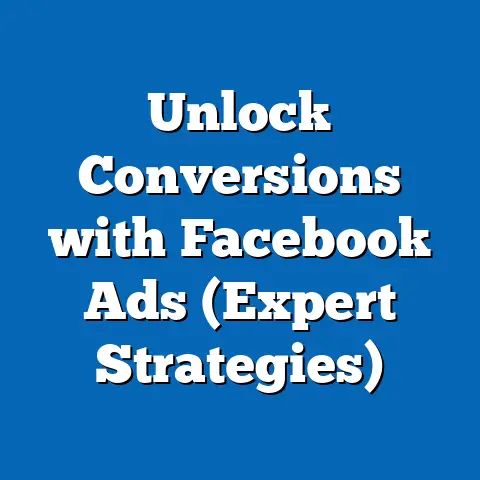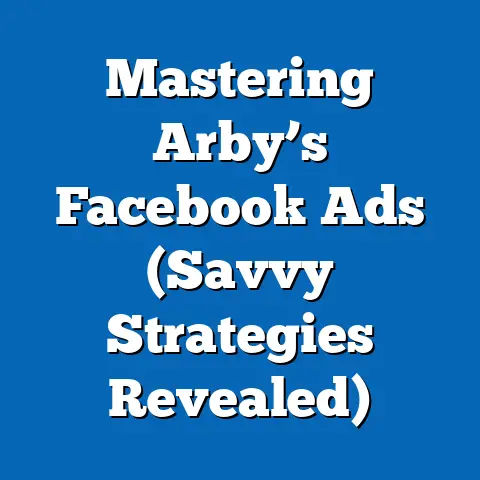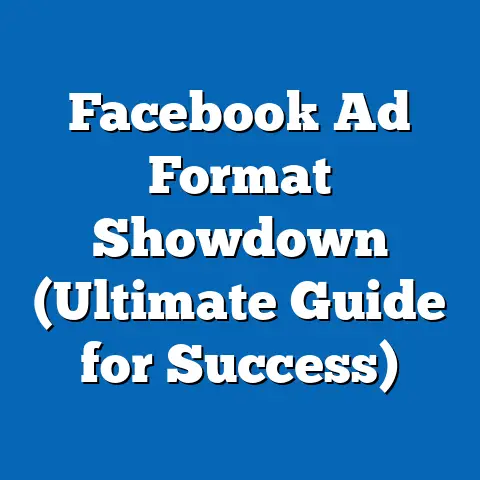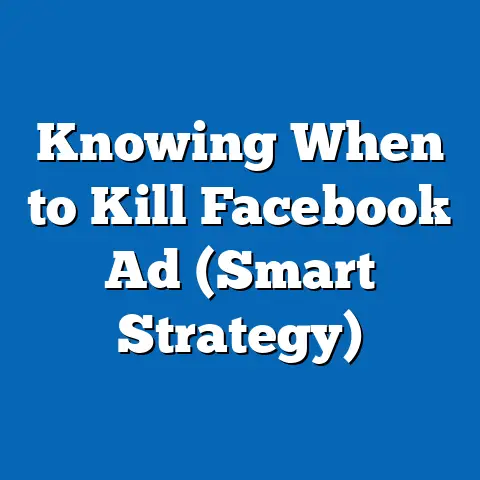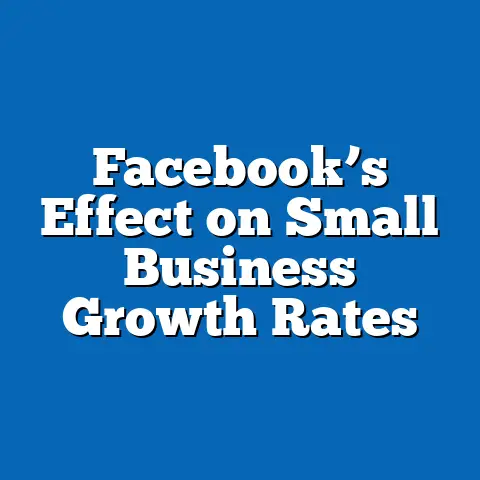Boost Engagement: Add Facebook Ads to Instagram (Pro Tips)
Boost Engagement: Add Facebook Ads to Instagram (Pro Tips)
Remember Pygmalion, the sculptor in Greek mythology who fell in love with his own creation? Well, as marketers, we often pour our hearts and souls into crafting the perfect digital campaigns. We meticulously sculpt the visuals, refine the copy, and obsess over the targeting, hoping to create something truly captivating. But here’s the thing: a beautiful sculpture is only appreciated when it’s seen. And in today’s digital landscape, that means maximizing engagement across all relevant platforms, especially on visually-driven powerhouses like Instagram.
In this guide, I’ll walk you through how to leverage the power of Facebook ads to boost your Instagram engagement. We’ll cover everything from understanding the synergy between these two platforms to crafting compelling ad creatives and targeting the right audiences. Get ready to transform your Instagram presence and forge deeper connections with your followers.
Understanding the Power of Cross-Platform Advertising
Let’s start with the basics: Facebook and Instagram are siblings, both under the Meta umbrella. This shared parentage means they share a common advertising infrastructure – Facebook Ads Manager. This is a HUGE advantage for us marketers. It allows us to create and manage ads for both platforms from a single interface, streamlining the entire process.
The Facebook-Instagram Connection
Think of Facebook as the experienced, data-rich elder sibling and Instagram as the hip, visually-focused younger sibling. Facebook boasts a massive user base with incredibly detailed demographic and interest data. Instagram, on the other hand, thrives on visual storytelling, authentic content, and a highly engaged audience.
By strategically using Facebook ads to drive traffic and engagement to your Instagram profile, you’re essentially tapping into the best of both worlds. You’re leveraging Facebook’s powerful targeting capabilities to reach the right audience on Instagram, where they’re more likely to engage with visually appealing content.
Statistics Speak Volumes
The synergy between Facebook and Instagram isn’t just anecdotal; it’s backed by data.
- Increased Reach: Studies have shown that running ads on both Facebook and Instagram can increase your overall reach by up to 9%. This means you’re getting your message in front of more potential customers.
- Higher Engagement Rates: Instagram generally sees higher engagement rates than Facebook, particularly among younger demographics. By using Facebook ads to direct users to your Instagram profile, you can capitalize on this higher engagement potential.
- Improved Brand Awareness: Consistent presence across both platforms strengthens brand recognition and builds trust with your target audience.
Why a Unified Strategy Matters
Trying to manage separate advertising strategies for Facebook and Instagram is like trying to conduct an orchestra with two different conductors. It’s chaotic and inefficient. A unified strategy, managed through Facebook Ads Manager, offers several key benefits:
- Centralized Management: Easily create, manage, and track your campaigns from a single dashboard.
- Consistent Branding: Ensure your messaging and visuals are consistent across both platforms, reinforcing your brand identity.
- Cross-Platform Optimization: Leverage data from both platforms to optimize your campaigns for maximum performance.
- Cost Efficiency: Avoid duplicating efforts and potentially save money by streamlining your advertising spend.
Takeaway: Facebook and Instagram are a dynamic duo. By understanding their relationship and implementing a unified advertising strategy, you can significantly boost your brand’s visibility, engagement, and ultimately, your bottom line.
Crafting Compelling Ads for Instagram
Now that we’ve established the importance of cross-platform advertising, let’s talk about creating ads that actually resonate with Instagram users. Remember, Instagram is a visual-first platform. People come to Instagram to be inspired, entertained, and connected through images and videos. Your ads need to seamlessly blend into this environment.
The Visual Imperative
On Instagram, visuals aren’t just important; they’re everything. Your ad’s image or video is the first thing users will see, and it’s what will determine whether they stop scrolling or keep moving. Here are some tips for creating eye-catching visuals:
- High-Quality Imagery: This should be a no-brainer, but it’s worth repeating. Use high-resolution images and videos that are well-lit, in focus, and visually appealing.
- Mobile-First Design: Remember that most Instagram users are accessing the platform on their mobile devices. Design your visuals with smaller screens in mind.
- Brand Consistency: Maintain a consistent visual style that aligns with your brand’s identity. Use your brand colors, fonts, and imagery to create a cohesive look and feel.
- Experiment with Different Formats: Instagram offers a variety of ad formats, including single image ads, video ads, carousel ads, and collection ads. Experiment with different formats to see what works best for your audience.
- Showcase Your Product or Service in Action: Don’t just show static images of your product or service. Show it being used in real-life scenarios. This helps users visualize how it can benefit them.
The Power of Storytelling
While visuals are crucial, they’re only half the battle. Your ad copy needs to be just as compelling. Instagram users are drawn to authentic stories and relatable experiences. Here’s how to incorporate storytelling into your ads:
- Focus on Benefits, Not Features: Instead of simply listing the features of your product or service, focus on the benefits it provides to the user. How will it make their life easier, better, or more enjoyable?
- Use Emotional Language: Tap into the emotions of your target audience. Use language that evokes feelings of excitement, joy, inspiration, or even nostalgia.
- Tell a Compelling Narrative: Craft a short, engaging story that resonates with your target audience. This could be a customer testimonial, a behind-the-scenes look at your business, or a personal anecdote from your founder.
- Keep it Concise: Instagram users have short attention spans. Get to the point quickly and use clear, concise language.
- End with a Strong Call to Action: Tell users exactly what you want them to do next. Do you want them to visit your website, follow your account, or make a purchase? Make it clear and easy for them to take action.
My Experience: I once ran an Instagram ad campaign for a local coffee shop. Instead of just showing pictures of coffee cups, we created a short video showcasing the warm, inviting atmosphere of the shop. We included snippets of customers laughing, baristas crafting beautiful latte art, and the aroma of freshly brewed coffee filling the air. The ad copy told the story of how the coffee shop was a community hub where people could connect and unwind. The result? A significant increase in foot traffic and a surge in new followers on Instagram.
Takeaway: Crafting compelling ads for Instagram requires a blend of stunning visuals and captivating storytelling. Focus on creating content that resonates with your target audience on an emotional level and inspires them to take action.
Targeting the Right Audience
You can have the most beautiful and compelling ad in the world, but if you’re showing it to the wrong people, it’s going to fall flat. That’s where Facebook’s advanced targeting options come in. The key is to understand your audience and use Facebook Ads Manager to reach them effectively.
Demographics and Behaviors
Facebook Ads Manager allows you to target users based on a wide range of demographic and behavioral factors, including:
- Age: Target specific age groups that are most likely to be interested in your product or service.
- Gender: Target men, women, or both.
- Location: Target users in specific cities, states, countries, or even within a certain radius of your business.
- Interests: Target users based on their interests, hobbies, and passions.
- Behaviors: Target users based on their online behaviors, such as purchase history, website visits, and app usage.
- Education: Target users based on their education level.
- Relationship Status: Target users based on their relationship status.
- Job Title: Target users based on their job title or industry.
Analyzing Your Audience
Before you start creating your ad campaigns, take the time to analyze your existing customer base. Who are they? What are their interests? Where do they live? What are their online behaviors?
You can use tools like Facebook Analytics, Google Analytics, and customer surveys to gather this information. Once you have a clear understanding of your audience, you can use Facebook Ads Manager to create highly targeted campaigns that are more likely to resonate with them.
Custom and Lookalike Audiences
Facebook also offers two powerful targeting options: custom audiences and lookalike audiences.
- Custom Audiences: A custom audience is a list of people you already know, such as your email subscribers, website visitors, or app users. You can upload this list to Facebook and target them with your ads. This is a great way to re-engage existing customers or promote special offers to loyal fans.
- Lookalike Audiences: A lookalike audience is a group of people who share similar characteristics to your existing customers. Facebook uses its vast database to identify users who are likely to be interested in your product or service based on their demographics, interests, and behaviors. This is a great way to expand your reach and find new customers who are similar to your best customers.
My Insight: I once worked with a client who was struggling to reach new customers on Instagram. After analyzing their customer data, we discovered that their ideal customer was a female aged 25-35, interested in yoga, healthy eating, and sustainable living. We created a lookalike audience based on their existing customer list and targeted them with ads promoting their eco-friendly yoga mats. The result was a significant increase in website traffic and a surge in new sales.
Takeaway: Effective targeting is crucial for maximizing the impact of your Facebook ads on Instagram. Take the time to understand your audience and use Facebook Ads Manager’s advanced targeting options to reach the right people with the right message.
Engaging with Interactive Content
Instagram is all about interaction. It’s a platform where users connect with each other, share their experiences, and engage with brands they love. To truly boost your engagement on Instagram, you need to create interactive content that encourages users to participate.
Exploring Instagram Formats
Instagram offers a variety of formats that you can use to create interactive content, including:
- Stories: Stories are short-form videos or images that disappear after 24 hours. They’re a great way to share behind-the-scenes content, run polls and quizzes, and engage with your audience in a fun and informal way.
- Reels: Reels are short, entertaining videos that can be up to 90 seconds long. They’re a great way to showcase your creativity, share tutorials, and participate in trending challenges.
- IGTV: IGTV is Instagram’s long-form video platform. It’s a great way to share in-depth content, host webinars, and connect with your audience on a deeper level.
- Live: Instagram Live allows you to broadcast live videos to your followers. It’s a great way to host Q&A sessions, announce new products, and interact with your audience in real-time.
Interactive Content Strategies
Here are some strategies for creating interactive content that will boost your engagement on Instagram:
- Polls and Quizzes: Use polls and quizzes in your Stories to ask your audience questions, gather feedback, and learn more about their preferences.
- Question Stickers: Use question stickers in your Stories to ask your audience what they want to know about your brand, product, or service.
- Countdown Stickers: Use countdown stickers in your Stories to create excitement and anticipation for upcoming events, product launches, or special offers.
- User-Generated Content (UGC): Encourage your followers to create and share content related to your brand. This could be anything from customer testimonials to photos of them using your products. Reposting UGC on your account is a great way to show your appreciation and build a sense of community.
- Challenges and Contests: Host challenges and contests on Instagram to encourage participation and generate buzz around your brand. Offer prizes to the winners to incentivize participation.
The Power of Call-to-Action (CTA) Buttons
Every ad should have a clear call to action. Tell users exactly what you want them to do next. Instagram offers a variety of CTA buttons that you can use in your ads, including:
- Shop Now: Directs users to your online store.
- Learn More: Directs users to your website.
- Sign Up: Directs users to a registration page.
- Download: Directs users to download an app or file.
- Book Now: Directs users to a booking page.
- Contact Us: Directs users to a contact form.
Make sure your CTA button is visually prominent and easy to click. Use clear, concise language that tells users exactly what they’ll get when they click the button.
My Tip: I’ve found that using a sense of urgency in your CTA can often boost conversions. For example, instead of saying “Learn More,” try saying “Discover Now” or “Get Started Today.”
Takeaway: Interactive content is key to driving engagement on Instagram. Use a variety of formats and strategies to encourage participation and build a strong community around your brand.
Measuring Success and Optimizing Campaigns
Creating engaging ads and targeting the right audience is only half the battle. You also need to track your results and optimize your campaigns for maximum performance. Facebook Ads Manager provides a wealth of data that you can use to measure your success and make data-driven adjustments.
Key Performance Indicators (KPIs)
Here are some key performance indicators (KPIs) to track when measuring the success of your Facebook ads on Instagram:
- Reach: The number of unique users who saw your ad.
- Impressions: The number of times your ad was displayed.
- Click-Through Rate (CTR): The percentage of users who clicked on your ad.
- Engagement Rate: The percentage of users who liked, commented on, or shared your ad.
- Cost Per Click (CPC): The average cost you paid for each click on your ad.
- Cost Per Thousand Impressions (CPM): The average cost you paid for every 1,000 impressions of your ad.
- Conversion Rate: The percentage of users who completed a desired action, such as making a purchase or signing up for a newsletter.
- Return on Ad Spend (ROAS): The amount of revenue you generated for every dollar you spent on advertising.
Analyzing Campaign Performance
Use Facebook Ads Manager to track your KPIs and analyze your campaign performance. Pay attention to trends and patterns in your data. Which ads are performing well? Which ads are underperforming? Which audiences are responding best to your ads?
Use this information to make data-driven adjustments to your campaigns. Try different ad creatives, targeting options, and bidding strategies to see what works best for your audience.
A/B Testing
A/B testing is a powerful technique for optimizing your Facebook ads. It involves creating two versions of an ad with slight variations and testing them against each other to see which performs better.
For example, you could A/B test different headlines, images, or CTA buttons. Run both ads simultaneously and track their performance. The ad that generates the most clicks, engagement, or conversions is the winner.
My Pro Tip: I always recommend testing one variable at a time. This allows you to isolate the impact of each change and determine what’s truly driving performance.
Takeaway: Measuring success and optimizing your campaigns is an ongoing process. Track your KPIs, analyze your data, and use A/B testing to continuously improve your results.
Case Studies and Real-World Examples
Let’s take a look at some real-world examples of brands that have successfully integrated Facebook ads into their Instagram strategy.
- Daniel Wellington: The watch brand Daniel Wellington built its entire brand on Instagram through influencer marketing and visually stunning ads. They used Facebook ads to target users with interests in fashion, travel, and lifestyle, driving them to their Instagram profile and online store.
- Airbnb: Airbnb uses Facebook ads to target travelers with personalized recommendations based on their interests and travel history. They use visually appealing images and videos of unique properties around the world, enticing users to book their next vacation through Airbnb.
- Gymshark: The fitness apparel brand Gymshark built a massive following on Instagram through a combination of influencer marketing, user-generated content, and engaging ads. They use Facebook ads to target users with interests in fitness, health, and wellness, driving them to their Instagram profile and online store.
Lessons Learned:
- Visual Storytelling is Key: All three brands prioritize visually appealing content that resonates with their target audience.
- Targeting is Crucial: They use Facebook ads to target specific demographics and interests, ensuring their ads are seen by the right people.
- Engagement is Essential: They encourage user-generated content, run contests and giveaways, and engage with their followers on a regular basis.
Takeaway: These case studies demonstrate the power of integrating Facebook ads into your Instagram strategy. By focusing on visual storytelling, targeted advertising, and engaging content, you can build a strong brand presence on Instagram and drive significant results.
Conclusion
Integrating Facebook ads into your Instagram marketing strategy is no longer a luxury; it’s a necessity. Much like the art of storytelling, successful advertising requires creativity, audience understanding, and continuous refinement. By following the tips and strategies outlined in this guide, you can transform your Instagram presence and forge deeper connections with your audience.
Now, I challenge you to start experimenting with your ad campaigns. Don’t be afraid to try new things, test different approaches, and see what works best for your brand. The key is to be creative, be persistent, and always be learning. Go out there and create some magic! And just like Pygmalion, you might just fall in love with the engaging campaigns you create.

